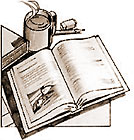
Atlas F1 Columnist
FIRST AMONG CHAMPIONS:
THE ALFA ROMEO GRAND PRIX CARSBy David Venables.
Published by Haynes.
That said, it's surprising that, until this book was released last year, there had not been a full-length history written of the team's complete involvement in Grand Prix racing. David Venables has taken it upon himself to try to fill the gap, and he has gone in with all guns blazing. While many books that are published in the 'coffee table' format make for relatively quick reading, 'First Among Champions' demands that you set aside a serious chunk of time if you want to explore it fully.
Venables goes into admirable detail as he takes the reader though the entire Grand Prix racing history of the marque, from the circumstances that led to its foundation, to the chain of events that saw the team close its garage doors for the last time at Adelaide in 1985. It's a long journey, particularly if it is to be told properly, and it seems that Venables has made a serious effort to cover and encompass every factor that played a part in shaping the fortunes of the team throughout the years.
Alfa's long tenure in Grand Prix racing leads to some great spin-off benefits where this book is concerned. With the team itself serving as a constant reference point, the reader gets a glimpse of some fascinating subplots. First, there is the development of Grand Prix racing itself. Motorsport was in its infancy when Alfa Romeo first came onto the scene, and in many respects the earliest period covered in the book tells you as much about the development of top-level racing as it does about one of its keenest participants. We see the Scuderia Ferrari, the team which, in a sense, carries Alfa's legacy in the modern era, both through its heritage and its distinctive red livery, emerge from within the Alfa organisation.
The reader is 'on the spot' when the loose arrangement of Grand Prix races around the place are organised into a formal World Championship, they see the emergence of Formula One, and they are also exposed to some of the great road races that particularly characterised the prewar era – the Coppa Floria, the Mille Miglia, the Targa Florio, and so on.
I also enjoyed having a new vantage point from which to follow the changing fortunes of some of the team's opposition through the years, from the earlier threats like Bugatti, through the Auto Unions and Mercedes-Benz teams immediately prior to WW2, and ending with the multitude of heavily liveried machines of the wings'n'slicks era.
Then there's also the changing backdrop of world affiars, particularly where the role of motorsport in Hitler and Mussolini's particular brand of politics was concerned. This was especially interesting, because while I was familiar with the story from a German perspective having read a number of books about Mercedes, it did not dawn on me until later that it was the first time I had read about it in an Italian context.
Naturally, the chronological account of the team's past makes up the main body of the book, but there are some real gems hidden away at the back. The first, and something that would make a useful addition to many other books of the genre, is a collection of biographies, each a few paragraphs long, of all the drivers who won three or more major races for Alfa Romeo. It scarcely needs to be said that this includes some of the greatest names from the earlier years of the sport – Antonio Ascari, Rudi Caracciola, Juan Manuel Fangio and Tazio Nuvolari for example, as well as a couple that I had heard of but knew less about, such as Gastone Brilli Perri and Antonio Brovio.
While the information doubles up to a large degree with the stuff contained in the main part of the book, it's still useful as a quick reference source. Several of the bios are accompanied by portrait shots.
Also interesting was the second appendix, which gives a basic rundown of the technical specifications of all the major race cars built by Alfa Romeo, including basic diagrams of the major engines. Good stuff, even for those who, like me, are a bit of a technical gumby, and again a useful reference for the future. The book concludes with a list of the marque's major wins and a fairly substantial, though unfortunately not annotated, bibliography.
The broad-page format of the book is designed to maximize the impact of the photos, and it works well. The shots are well chosen and well reproduced, particularly where the older shots are concerned, and most are provided with informative captions. If you have a penchant for racing history and you are keen for a way to kill time during the off-season, then this book will almost certainly keep you going for a while. It may be a little more expensive than many of the other books that find their way onto my desk, but you do get a lot for your money.
While many racing books tend to be quickly read and even more quickly forgotten, this is one that imagine will become rather dog-eared in the coming years from me flipping it open to search for some particular detail.
There are so many popular sayings that could appropriately serve as openings to a review of a book about the history of Alfa Romeo in Grand Prix racing – 'all things must pass', 'nothing lasts forever', maybe even 'how the mighty have fallen'. With sixteen years between the marque's last race and the present – and an even wider gap between now and the last time that the team represented a formidable challenge to their opposition – it's difficult to appreciate the extent to which they dominated during their formative years during the first half of the twentieth century.
Please Contact Us for permission to republish this or any other material from Atlas F1.
|
Volume 7, Issue 43
Atlas F1 Exclusive
Parting is Such Sweet Sorrow
2001 Season Review
The 2001 Race-by-Race Review
The 2001 Drivers Review
The 2001 Teams Review
The Atlas F1 Top Ten
Columns
The 2001 Season Mega Quiz
Elsewhere in Racing
The Bookworm Critique
The Weekly Grapevine
> Homepage |


